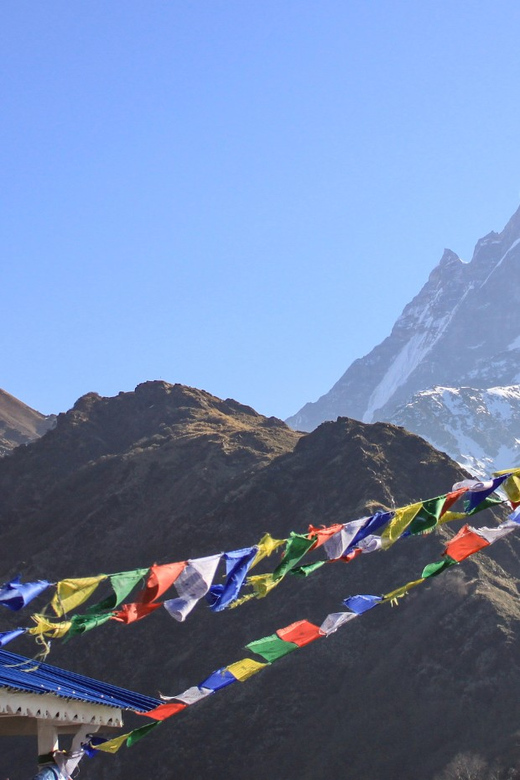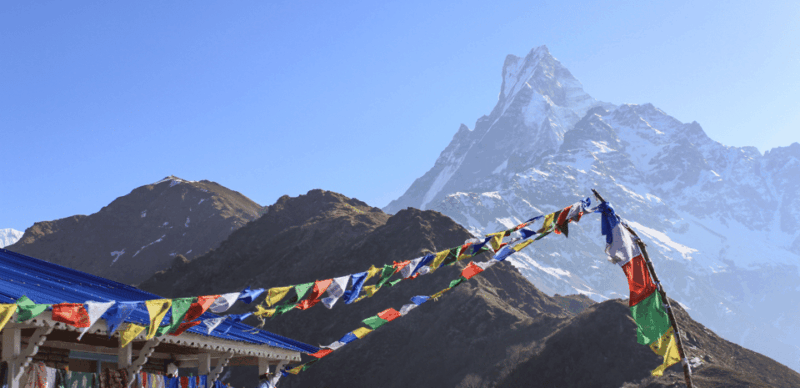The Mardi Himal Trek offers a unique opportunity for trekkers seeking a concise yet rewarding experience in the Annapurna Region. Spanning seven days, this moderate trek showcases breathtaking views of Mt. Fishtail while guiding adventurers through picturesque villages rich in culture. With basic accommodations and local cuisine, trekkers can enjoy the authentic Himalayan lifestyle. As they navigate varied terrain and shifting altitudes, understanding the trek’s itinerary, preparation tips, and best seasons becomes essential. What challenges and surprises await those who embark on this journey?
Key Points

- The Mardi Himal Trek is a seven-day journey in the stunning Annapurna Region, offering breathtaking views of Mt. Fishtail and the Annapurna range.
- This trek features moderate difficulty, making it accessible to various skill levels, including beginners and experienced trekkers.
- The route includes cultural experiences with authentic Pun and Gurung villages, allowing for interaction with local communities.
- Autumn and spring are the best seasons for trekking, providing vibrant landscapes and blooming rhododendrons.
- Basic accommodations and meals are provided in teahouses, enriching the trekking experience with local culture and cuisine.
Trek Overview and Highlights

The Mardi Himal Trek offers adventurers a captivating experience through the Annapurna Region, showcasing stunning views of iconic peaks like Mt. Fishtail and the Annapurna range.
This seven-day trek, starting from Thamel in Pokhara, provides an opportunity to explore authentic Pun and Gurung tribal villages. Hikers will encounter breathtaking landscapes filled with diverse flora and fauna, making every step worthwhile.
The trek is considered moderate, making it accessible for various skill levels while still presenting a challenge. Close-up views of the majestic Himalayan peaks serve as a constant reminder of nature’s grandeur.
You can also read our reviews of more tours and experiences in Deurali.
Itinerary and Route Details
Beginning the adventure with a bus tour from Kathmandu to Phedi, trekkers will embark on a journey that unfolds over seven days through the stunning landscapes of the Annapurna Region.
The trek kicks off with a guided tour to Deurali, taking about 5.75 hours. Next, trekkers reach Forest Camp for an overnight stay after a scenic 6-hour walk.
The following day, they continue to Mardi Himal Low Camp, enjoying breathtaking views. After resting, they’ll ascend to Mardi Himal High Camp, the highest point at 4,500m, in roughly 5 hours.
The return journey includes a stop at Siding Village before heading back to Pokhara and finally Kathmandu, wrapping up an unforgettable trekking experience.
Inclusions and Costs

After completing the breathtaking trek, participants can expect a comprehensive package of inclusions and costs that ensures a smooth and enjoyable experience. The trek starts at a price of Kč14,535 per person, covering essential elements like the Annapurna Conservation Area Entry Pass and TIMS Card.
An experienced Himalayan trek guide accompanies trekkers, providing insight and support throughout the journey. Basic accommodations and meals in teahouses are included, along with a general first aid medicine kit for safety. Participants also receive a complimentary T-shirt and duffle bag.
However, personal expenses, tips for staff, and costs incurred due to natural calamities aren’t included, ensuring trekkers are well-prepared for their adventure.
Preparation and Recommendations

Proper preparation is essential for a successful Mardi Himal Trek, ensuring trekkers are equipped for the challenges and beauty that lies ahead.
To maximize the experience, trekkers should consider the following recommendations:
-
Warm clothing: Layered outfits for varying temperatures.
-
Outdoor gear: Comfortable, quick-dry clothing and sturdy trekking boots.
-
Sun protection: A wide-brimmed hat and biodegradable sunscreen.
-
Hydration supplies: A reusable water bottle to stay hydrated.
-
First aid kit: Basic supplies for minor injuries or ailments.
The best trekking seasons are autumn (September to November) and spring (March to May).
Plus, trekkers should prepare physically to adapt to high altitudes and drink plenty of water to mitigate altitude sickness.
This preparation sets the stage for unforgettable adventures in the Annapurna region.
More Great Tours NearbyImportant Information and Restrictions
Trekkers should be aware of important information and restrictions that will enhance their safety and enjoyment during the Mardi Himal Trek.
First, cancellation is free up to 24 hours in advance for a full refund. However, this trek isn’t suitable for babies under one year or individuals over 95 years.
Plus, alcohol and drugs aren’t allowed in vehicles.
The trek typically involves tea house accommodations, offering a taste of local culture. Trekkers can enjoy traditional meals like Dal Bhat, known for its high nutritional value.
It’s vital to follow these guidelines to ensure a smooth experience while respecting local regulations and customs, ultimately leading to a memorable adventure in the Annapurna region.
Best Seasons for Trekking
Choosing the right season for the Mardi Himal Trek can significantly enhance the trekking experience, with autumn and spring being the most favorable times to embark on this adventure. During these seasons, trekkers can enjoy mild weather, clear skies, and stunning views of the Annapurna range.
Autumn (September to November): Ideal for vibrant landscapes and pleasant temperatures.
Spring (March to May): Offers blooming rhododendrons and moderate weather.
Avoid Monsoon (June to August): Heavy rainfall can hinder visibility and trekking conditions.
Winter (December to February): Cold temperatures may deter trekkers, but fewer crowds exist.
Overall: Each season has its charm, but autumn and spring typically provide the best trekking conditions.
Altitude Sickness Tips

To prevent altitude sickness during the Mardi Himal Trek, it’s crucial to stay well-hydrated and acclimatize gradually to the higher elevations.
Trekking at altitudes above 2,500 meters increases the risk of altitude sickness, so trekkers should ascend slowly and take rest days if necessary. They should also listen to their bodies; symptoms like headaches, dizziness, or nausea require immediate attention.
Consuming high-carbohydrate meals can help maintain energy levels, while avoiding alcohol and smoking is vital. If symptoms worsen, descending to a lower altitude is often the best solution.
Cultural Experiences Along the Trek

Cultural encounters along the Mardi Himal Trek offer trekkers a unique glimpse into the rich traditions and vibrant lifestyles of the local Pun and Gurung communities. As trekkers navigate through this stunning landscape, they’ll experience authentic cultural interactions that enhance their journey.
-
Traditional festivals showcasing local music and dance
-
Opportunities to participate in daily rituals and practices
-
Visits to ancient temples and sacred sites
-
Insights into local cuisine, including the popular Dal Bhat
-
Engaging conversations with villagers about their history and lifestyle
These experiences not only enrich the trek but also foster a deeper appreciation for the region’s heritage, creating lasting memories that go beyond the breathtaking views.
Frequently Asked Questions
What Is the Difficulty Level of the Mardi Himal Trek?
The trek’s difficulty level is moderate. Hikers encounter diverse terrains and varying altitudes, making it accessible for those with basic fitness. Proper preparation and acclimatization can enhance the experience, ensuring an enjoyable adventure for participants.
Are There Any Age Restrictions for Participants?
There’re specific age restrictions for participants. Babies under one year and individuals over 95 years aren’t allowed. It’s essential to ensure everyone’s safety and enjoyment during the trek, regardless of their age.
Is It Possible to Customize the Trek Itinerary?
They can customize the trek itinerary based on preferences and fitness levels. The trek organizers typically offer flexible options, allowing participants to adjust daily distances, accommodations, and activities for a more personalized experience.
What Types of Food Are Available Along the Trek?
Along the trek, trekkers find various food options, including traditional Nepali dishes like Dal Bhat, noodles, and fried rice. They can enjoy fresh fruits, snacks, and tea, ensuring plenty of nourishment during their journey.
How Can I Stay Connected or Access Wi-Fi During the Trek?
During the trek, she found limited Wi-Fi access in teahouses. To stay connected, she used a portable hotspot or offline maps, ensuring she downloaded important information beforehand. Staying prepared kept her connected with family and friends.
Recap
The Mardi Himal Trek offers an unforgettable experience for trekkers of all skill levels, showcasing the stunning beauty of the Annapurna Region.
With its captivating views, rich cultural experiences, and moderate difficulty, it’s an ideal choice for those seeking adventure and connection to nature.
By preparing adequately and choosing the right season, adventurers can fully enjoy this breathtaking journey.
Whether it’s your first trek or a returning exploration, Mardi Himal promises to leave lasting memories.
You can check availability for your dates here: